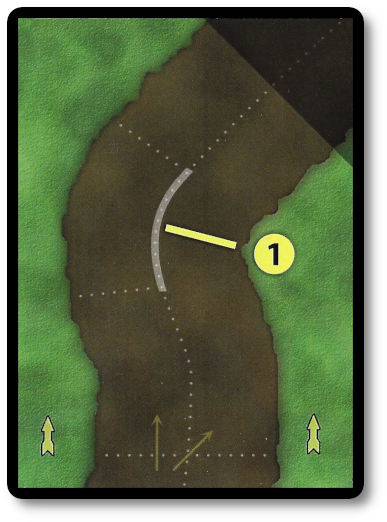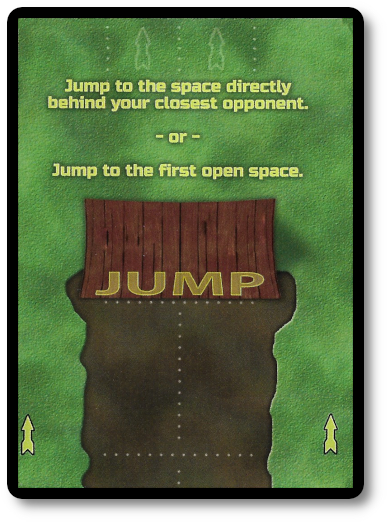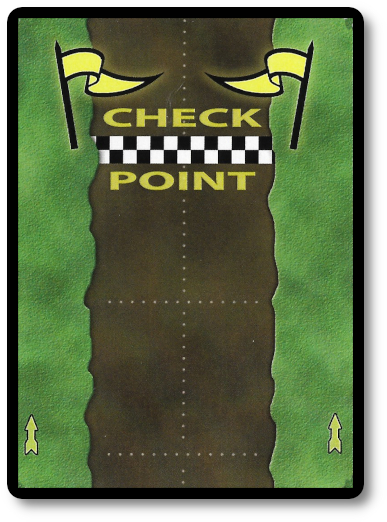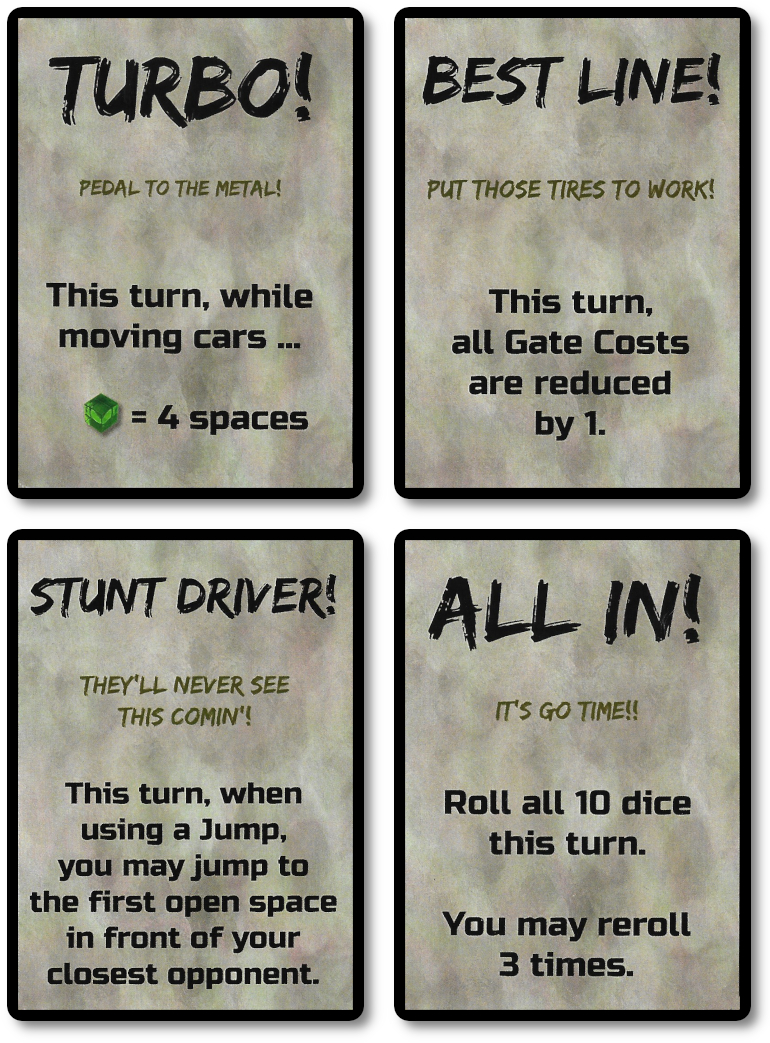 The Basics:
The Basics:
- For ages 10 and up (publisher suggests 12+)
- For 1 to 4 players
- Approximately 30 minutes to complete
Geek Skills:
- Counting & Math
- Logical & Critical Decision Making
- Reading
- Strategy & Tactics
- Risk vs. Reward
- Visuospatial Skills
- Hand/Resource Management
Learning Curve:
- Child – Easy
- Adult – Easy
Theme & Narrative:
- Shift into gear and rip up the dirt as you race to the finish!
Endorsements:
- Gamer Geek approved!
- Parent Geek approved!
- Child Geek approved!
Overview
One of the most successful racing drivers in the history of the sport, Mario Andretti, said, “If everything seems under control, you’re just not going fast enough.” In this game, control is necessary to win with your two-car team, but victory is not given to the fastest. As your team lead, you must manage your resources, timing, and position to take the lead and score the points.
Dicey Curves: Road Rally, designed by Matt Worden and published by Matt Worden Games, is comprised of one Current Driver card, one stand (to be used to hold the Current Driver card), four Player Reference cards, eight Race Car miniatures (in four different colors, two per color), 16 Skill cards, 16 Track cards, 30 Score cards, 32 Control tokens, 32 Fuel tokens, and 10 standard six-sided dice. The cards are durable and less flimsy than your standard playing card. All the other components are made of solid plastic. Also, by Matt Worden, the artwork is minimal but more than sufficient for easy gameplay and strengthening its overall narrative.
Prepping for the Big Race
To set up the game, first have each player selects a pair of matching colored Race Car miniatures and Player Reference cards.
Second, determine now who will be the starting player. The player designed as “First” is now given three Control tokens, three Fuel tokens, and the “Current Driver” card with stand. The “Second” player (the one directly to the first player’s left in turn order sequence) is given four Control tokens and three Fuel tokens. All remaining players are given four Control tokens and four Fuel tokens. Place the remaining Control and Fuel tokens to one side in “pools” (which is a fun way of saying “organized pile”).
Third, all dice are now given to the “Current Driver.” The game rules suggest the box top of the game be used as an ad hoc dice box. I strongly suggest you do. It makes it very easy to pass the components around the table.
Fourth, give each player a set of Skill cards. This is comprised of one “Turbo,” one “Best Line,” one “Stunt Driver,” and one “All In” Skill card.
Fifth, find the double-sided “Start” Track card and place it near one of the playing area edges, for example, towards the end of your gaming table.
Sixth, find the two “Jump” and three “Checkpoint” Track cards and set them aside. Take the remaining Track cards and shuffle, placing them face-down. This deck is referred to as the “Random Track” deck.
Seventh, build the Track deck. This is done by taking a certain number of cards from the Random Track deck, placing them face-down, and placing the “Jump” and “Checkpoint” Track cards in the stack at certain times. The game rules explain how this is easily done. The result will be the game’s “Track” deck comprised of random curves and jumps in the track, always providing the players with unique twists and turns.
Eighth, draw the first three Track cards and place them on the table by connecting the road portion. A yellow arrow is provided on each of the cards to help define the direction they should be placed.
Ninth, separate the “Lead Car” Score cards by color, forming them into stacks with the “1” Score value on the bottom and the “5” Score value at the top. Do the same with the “Trail Car” Score cards. Place these stacks near your pool of tokens.
That’s it for the game set up. Admittedly, it reads like many steps, but the actual process takes only a few minutes.
Petal to the Proverbial Metal
Dicey Curves: Road Rally is played in turns with no set number of turns per game. A player’s turn is summarized here.
Step One: Move Those Cars!
A player can take this step as soon as they are passed the “Current Driver” card.
On the player’s first turn of the game, they will take their two Car miniatures and place them on the “Start” Track card. A player moves one of their two Car miniatures up to three spaces on the Track cards for each one Fuel token spent. There is no limit to the number of times a player can move their Car tokens. As long as they have fuel to burn, they may push their cars along.
While moving the Car miniatures, a player cannot move the position through solid white lines or move diagonally (unless otherwise specified by the Track card). Also, a player may not move their Car miniature into a space already occupied by another miniature.
Some of the Track cards will have a “Gate” line with a number value. Thematically speaking, these represent tricky portions of the track that will require the player to spend more time focusing on their driving and less time talking smack. The benefit thereof is a “shortcut” that will help the player’s car move faster on the track. To pass through these gates, the player must pay the same number of Control tokens as indicated by the number associated with the gate. For example, a Gate of two will require the player to pay two Control tokens. Failure to do so means the player’s car cannot traverse that specific portion of the track.

While the Fuel and Control tokens have their own individual use, they can also be combined to ignore the physical world’s laws temporarily. This is referred to as “Ghosting” (which is not similar to what some people do on dating apps). By paying the Control token simultaneously as the Fuel token, the player can move through spaces occupied by another Car miniature. The player is still unable to end their car movement in a space occupied by another car.
When the player moves their Car miniatures, all spent tokens are returned to their matching pools. Players keep any unspent tokens for future turns.
It is important to note that when a player moves their Car miniature forward on the track, the player should draw and attach new Track cards to the racecourse, so there are always three Track cards ahead of the lead Car miniature. Continue to add cards in this fashion until the Track deck is exhausted.
Step Two: Roll Them Dice!
The player now passes the “Current Driver” card to the next player in the turn order sequence if they were passed the dice and they are done moving their cars.
Each player will roll, at minimum, six dice on their turn. Additional dice (for a maximum of 10) can be added based on bonuses. The first bonus is “Team Racing,” which will give the player two additional dice if the player’s trail car (the car in the back) could reach the player’s lead car (the car in the front) in four moves. The second bonus is “Drafting,” which will give the player one additional die for each car directly behind another car.
Once the player determines the total number of dice they will roll, they take them all and roll them to the table. The player can, optionally, re-roll up to twice. Any dice can be re-rolled at a time, but those selected to be re-rolled must be done so as a group.
The objective is to roll dice with values that can be combined into a maximum of two combinations. Combinations include:
- A single die
- Two or more dice with the same number value
- Two or more dice in a numbered sequence
Once the player has created their combinations (ignoring any dice that do not fit into the two combinations created), the player determines which combination will cover their Fuel tokens and which will cover their Control tokens. The player takes one token for each die in the combination. For example, if the player had five dice in a combination and elects to use that combination for Fuel, they take five Fuel tokens.
The player is capped at collecting no more than eight tokens per combination.
Once the tokens are collected, pass the dice to the next player in the turn order sequence.
This completes the player’s turn, but we have a few more important player decisions to cover.
Jumps, Checks, and Sick Skills
If you recall, two special Track cards were added to the Track deck, as well as Skill cards passed out during the game set up. Let’s talk about them now.
Jumps
“Jump” Track cards allow the player to pull a Dukes of Hazzard stunt (uff da, I just dated myself), allowing them to jump ahead, literally. The jump allows the player to “jump over” the Car miniature in front of them and place their Car miniature to the first open space behind the closest opponent or move their Car miniature to the first open space on the next Track card.

Checkpoints
“Checkpoint” Track cards give player points. When the player passes the checkpoint for the first time with their first car, they take the top-most available “Lead Car” Score card. When their second Car miniature passes the checkpoint, they take the top-most available “Trail Car” Score card. Depending on when the player’s car passes the checkpoint, they will get different valued Score cards.

Skills
A player may use one or more Skill cards during their turn, but once they are used, they are discarded and no longer available for the duration. The benefits of the Skill card remains active for the duration of the player’s turn.
- “Turbo” gives the player extra movement per Fuel token spent
- “Best Line” reduces the cost to pass all Gates by one
- “Stunt Driver” changes the rules of how to resolve “Jump” Track cards
- “All In” allows the player to roll all 10 dice and use the option of re-rolling up to three times instead of two

Victory!
The race comes to an end when the last Car miniature crosses the last “Checkpoint” Track card (which also happens to be the last card to be placed on the race track). All players now add the values of their collected Score cards. The player with the highest total value wins the game. If there is a tie, the player who crossed the final checkpoint first with their lead car is declared the winner.
Game Variants
The base game comes with enough components to play with three to four players without issue. A game expansion is also available that provides the additional game components needed to play with five or six players. The gameplay is the same.
The game comes with Skill cards. We used these in all our games, but they are considered optional and can be removed when playing with less experienced players. The Skill cards can also be integrated into the game by randomly dealing out four Skill cards per player at the beginning.
Dicey Curves: Road Rally can also be played as a solo game. We did not try this game variant due to the game rules not being provided. As of this review, these rules are not yet available but will be freely provided from the Matt Worden Games website.
To learn more about Dicey Curves: Road Rally, visit the game’s web page.
Final Word
 The Child Geeks had a great time with the newest version of Dicey Curves. They found the gameplay to be fast and fun without being confused about how the cars move. The Skill cards were not used each time, even though they were available. According to one Child Geek, “I like the game. It moves just as fast as the race cars we are pretending to drive.” Another Child Geek said, “I like the game. I like the cards that give you bonuses, too, but I don’t think you need to use them to win.” Victory always went to the player who used their tokens the most aggressively, but there were a few times where players were stuck because they ran out of tokens. The Child Geeks sometimes forgot about their trailing car, leaving it well behind. Regardless, all the Child Geeks finished their races and declared the big winner to be Dicey Curves: Road Rally.
The Child Geeks had a great time with the newest version of Dicey Curves. They found the gameplay to be fast and fun without being confused about how the cars move. The Skill cards were not used each time, even though they were available. According to one Child Geek, “I like the game. It moves just as fast as the race cars we are pretending to drive.” Another Child Geek said, “I like the game. I like the cards that give you bonuses, too, but I don’t think you need to use them to win.” Victory always went to the player who used their tokens the most aggressively, but there were a few times where players were stuck because they ran out of tokens. The Child Geeks sometimes forgot about their trailing car, leaving it well behind. Regardless, all the Child Geeks finished their races and declared the big winner to be Dicey Curves: Road Rally.
 The Parent Geeks also found the game to be entertaining. Lighter than other racing games they have played in the past, which turned out to be more of a point for discussion rather than a point of concern. According to one Parent Geek, “This is a lighter version of other racing games I have enjoyed in the past. I find it to be easy to learn and entertaining to play. The random track placement each race is always visually interesting, too.” Another Parent Geek said, “This is one of those game genres I still don’t think the board game world is getting right. Difficult to capture the adrenaline and excitement of a race. This game didn’t make me sweat, but it always made me smile.” The Parent Geeks gave Dicey Curves: Road Rally the prize cup.
The Parent Geeks also found the game to be entertaining. Lighter than other racing games they have played in the past, which turned out to be more of a point for discussion rather than a point of concern. According to one Parent Geek, “This is a lighter version of other racing games I have enjoyed in the past. I find it to be easy to learn and entertaining to play. The random track placement each race is always visually interesting, too.” Another Parent Geek said, “This is one of those game genres I still don’t think the board game world is getting right. Difficult to capture the adrenaline and excitement of a race. This game didn’t make me sweat, but it always made me smile.” The Parent Geeks gave Dicey Curves: Road Rally the prize cup.
 The Gamer Geeks, who do enjoy more engrossing racing games, were pleased with Road Rally. They found the game to be a great mix of resource control and timing that blended into a seamless experience they all enjoyed. According to one Gamer Geek, “A fun game to put on the table as a filler or to get the gaming day started. I liked how much time and energy I had to put into it and how rewarding it was to blaze past the competition. Good stuff.” Another Gamer Geek said, “A game of moderate difficulty that puts you in the driving seat. I liked the control I had of my vehicles and how it provided a challenge of navigating the track and the competition. A good little game I’d play again.” When the last racecar pulled into the pit, the Gamer Geeks gave Dicey Curves: Road Rally their full approval.
The Gamer Geeks, who do enjoy more engrossing racing games, were pleased with Road Rally. They found the game to be a great mix of resource control and timing that blended into a seamless experience they all enjoyed. According to one Gamer Geek, “A fun game to put on the table as a filler or to get the gaming day started. I liked how much time and energy I had to put into it and how rewarding it was to blaze past the competition. Good stuff.” Another Gamer Geek said, “A game of moderate difficulty that puts you in the driving seat. I liked the control I had of my vehicles and how it provided a challenge of navigating the track and the competition. A good little game I’d play again.” When the last racecar pulled into the pit, the Gamer Geeks gave Dicey Curves: Road Rally their full approval.
 Dicey Curves: Road Rally is, in many respects, the spiritual successor of Dicey Curves. Improved and streamlined, the game feels tighter, better organized, and focused. This is not to say Dicey Curves was a hot mess, but Road Rally feels more polished.
Dicey Curves: Road Rally is, in many respects, the spiritual successor of Dicey Curves. Improved and streamlined, the game feels tighter, better organized, and focused. This is not to say Dicey Curves was a hot mess, but Road Rally feels more polished.
My favorite aspect of the game is resource control. Players are using their Fuel and Control tokens as quickly as they can to get ahead, but with limitations on their ability to do so. It makes each resource spent an exercise in serious thinking. For example, you could burn your fuel to jump ahead, but at what cost? You will leave yourself open to a fuel shortage if the dice don’t cooperate. The same goes for Control tokens, which might feel unnecessary if you don’t plan on using the Gates. However, ghosting is a necessary component in this competitive race game. In short, you have to watch your resources just as hawkishly as you watch the competition.
Managing two vehicles in the game isn’t a chore. It’s a challenge. Younger players tend to focus on one car, which is fine, but the race isn’t over until each car passes the last checkpoint. Experienced players will quickly see that the race is not about speed but positioning and timing. You don’t win because you are fast. You win because you were in a better position to collect points. Don’t confuse the two. If you do, you’ll be blinded by the fact that you’ll need to step on the break on purpose in some situations and push the limits in others. As a result, the game shifts gears constantly, but not to a point where it feels like it grinds them.
My biggest concern going into the game was the dice. Random outcomes to determine required resources to win – let alone play – the game felt like a gamble. In this case, it paid off. I never found the dice when playing or observing others to be an obstacle. There was always an outcome where resources were collected. What I found to be of true interest was how little players spent their resources. Not in the sense that they didn’t use them. The opposite was observed, in fact. What I found interesting was how, at first, all the players would be very reserved in their resource spending. The first game always felt like I watched a race where the players were 90-year-old, near-sighted drivers. That is to say, slow and cautious. Once the players started to see their resources building up and their lead diminishing, the engines started to rev up.
Do try Dicey Curves: Road Rally when time allows. It’s a great gateway game and leverages a solid ruleset and resource management to empower the player to be a reckless road warrior. No danger of ever crashing, but that won’t stop you from being cautious around ever turn. In this game, a slight lead could leave the competition in the dust or give you an unrealistic sense of victory. Either way, you’ll end your races feeling like a winner.
This game was given to Father Geek as a review copy. Father Geek was not paid, bribed, wined, dined, or threatened in vain hopes of influencing this review. Such is the statuesque and legendary integrity of Father Geek.



